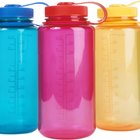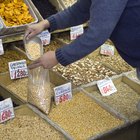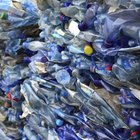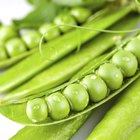With such a preponderance of kitchen utensils, dishes and supplies made from plastic, it can seem as though this ubiquitous material must be safe. However, some plastic products are not designed to be used for cooking meat. Whether you cook in a microwave, an oven or a toaster oven, choose safe plastic products to hold or cover your meat. Look for the words "microwave-safe" or "oven-safe" on the label.
Potential Harm
Not all plastics remain stable at high temperatures, such as those used for cooking meats. When used in a microwave or oven, some plastics release harmful chemicals, which are then transferred into the food. Some plastics will melt into the meat if they grow hot enough, rendering your meal inedible. Other, less-stable plastics can even catch on fire, causing burns and appliance damage.
Safe Choices
Most plastic products labeled as microwave- or oven-safe can be used to cook meats. These include plastic wrap designed for microwave use. However, even when you do use safe plastic wrap, do not let it touch the meat directly when cooking, as chemicals can migrate at temperatures as low as 350 to 400 degrees, according to Purdue University. Plastic oven-cooking bags are a safe choice for meats such as turkeys or roasts. Pop-up temperature indicators and the hock locks, or plastic holders that secure the legs of many turkeys and chickens, are also safe. Some meat and poultry is sold with a plastic net that holds it in place; these nets are generally safe to cook with, though they may melt in extremely high heat. The method of sous vide, or cooking meats in vacuum-sealed plastic bags specially designed for that purpose, is also safe.
Alternatives to Plastic
Fortunately, alternative meat-cooking methods exist. Instead of covering meats with plastic wrap in the oven, use a sheet of foil. A loosely placed foil covering can help seal in juices and flavors without imparting chemicals into the meat. Of course, foil can't be used to cook in the microwave. Instead, use a large, curved microwave-safe dish to cover meat and prevent splattering. Many glass or ceramic products are also designed for safe microwave use.
Avoid
To avoid potential harm from chemical transfer and burns, do not use plastic wrap that is not specially labeled for use in the microwave or oven. Don't cook in reusable containers that originally held products such as margarine or yogurt, as these do not hold up under high temperatures. Don't heat food in plastic zip-top or freezer bags, as they lose stability at high temperatures and can transfer chemicals to food.
Special Concerns
Sometimes certain plastics just slip under the radar, especially if you're busy with a large meal like Thanksgiving dinner. If you forget to take the plastic-bagged giblets out the turkey before cooking it, check the bag after you take the turkey out. If it has not been altered by the cooking process, the giblets are safe to use. However, if the bag has melted or changed shape, the giblets and meat should not be consumed. The same better-safe-than-sorry standards apply to the plastic bone protector on many hams and the plastic absorbency pad that comes under many meats. If you forget to remove them before cooking and the plastic emits an odor or taste, the meat should be discarded.
Related Articles

Heating Foods in Plastic & BPA

What Are the Dangers of Plastic Bags ...

The Safety of Refrigerators and ...

What Happens if You Cook Chicken With ...

Cooking With Glass Vs. Ceramic

Is It Safe to Cook Vegetables in ...

The Steps in Cooking Raw Foods in a ...

Which Plastic Bottles Are Safe?

What Are the Dangers of Tantalum?

What Is the Highest Temperature That ...

Do You Thaw Hamburger Patties Before ...

Can You Cook Pork Two Days After ...

How to Use Plastic Hair Curlers

How to Use Smartware Cookware

How to Disinfect Ear Plugs

What Is a Paraffin Bath?

What Are the Best Containers to Freeze ...

How Long Does Foil Keep Food Warm?

Types of Bag Handles

Plastic Recycling Levels
References
Resources
Writer Bio
Based in the Southwest, Linsay Evans writes about a range of topics, from parenting to gardening, nutrition to fitness, marketing to travel. Evans holds a Master of Library and Information Science and a Master of Arts in anthropology.